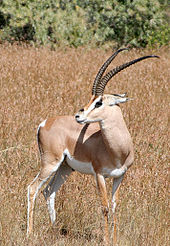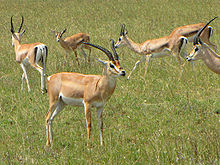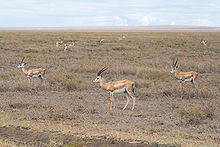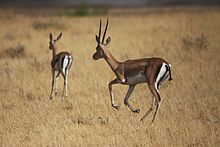- Grant's Gazelle
-
Grant's Gazelle 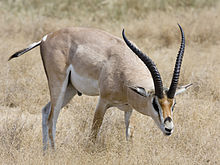
Conservation status Scientific classification Kingdom: Animalia Phylum: Chordata Class: Mammalia Order: Artiodactyla Family: Bovidae Subfamily: Antilopinae Genus: Nanger Species: N. granti Binomial name Nanger granti
(Brooke, 1872)[2]The Grant's gazelle (Nanger granti) is a species of gazelle. Its populations are distributed from northern Tanzania to southern Sudan and Ethiopia, and from the Kenyan coast to Lake Victoria.[3] Its Swahili name is Swala Granti.[4]
Contents
Taxonomy and genetics
Grant's gazelle is more genetically related to Soemmerring’s Gazelle (N. soemmerringii) and Thomson’s Gazelle (Eudorcas thomsonii) with Soemmering’s gazelle being the closest relative out of the two species.[3] Grant's gazelle shows high genetic variation among its populations even though there is no geographic isolation. The differentiation of the species may have evolved during repeated expansion and contraction of arid habitats during the late Pleistocene era in which populations were possibly isolated.[3] Grant's gazelle was formerly considered a member of the genus Gazella within the subgenus Nanger before Nanger was elevated to genus status.
Subspecies[2]
- Nanger granti brighti (Thomas, 1901) – Bright's Gazelle
- Nanger granti granti (Brooke, 1872) – Southern Grant's Gazelle
- Nanger granti lacuum (Neumann, 1906) – Northern Grant's Gazelle
- Nanger granti petersi (Günther, 1884) – Peter's Gazelle
- Nanger granti robertsi (Thomas, 1903) – Robert's Gazelle
Appearance
The Grant's Gazelle stands 75–90 cm (30–35 in) up to the shoulder and weighs 45–65 kg (99–140 lb).[4] Its coat is a beige orange on the back with a white belly. The Grant's Gazelle looks similar to a Thomson's Gazelle except it has lyre-shaped horns which are stout at the base, clearly ringed and measuring 45–81 cm (18–32 in) long. The subspecies are segregated by different morphological characters such as; horn shape and slight differences in coat colour.[3] These differences are not indicative of ecological separation as with some species.[3] They can reach running speeds of up to 80 to 90 km/h (50 to 56 mph).
Ecology
The Grant's gazelle is found in East Africa and lives in open grass plains and frequently found in shrublands; it avoids areas that have high grass where the visibility of predators is compromised. They also occur in semi-arid areas as well, and is relatively arid-adapted.[3] They are migratory animals but travel in the opposite direction of most of the other ungulates like Thompson's gazelles, zebras and wildebeests which are more water dependant. They can subsist on vegetation in waterless, semiarid areas. Here they face little competition.
Grant’s gazelles are generally mixed feeders that both browse and graze. Their average diet consists of 65.8% browse and 34.3% graze.[5] Rainfall in their habitats seem to be the determinant of their diets.[5] The Grant's gazelle's diet may also be responsible for the slow growth rates in the browsed plots.[6] They get most of their moisture from the plants they eat so they don’t have to drink water often. Thus they can stay on the plains long after the rains end. From July to September, gazelles move deep into dense brush and wait for the next rains.[7] They will eat red oats and small crunchy plants,[8] which are avoided by the other ungulates. This allows the gazelles to survive in the brush during the dry season. Grant’s gazelles eat mainly dicotyledons during the dry season and grass in the wet season.[9]
The most common predators of the Grant's gazelle are cheetahs[10] and wild dogs. Humans also tend to hunt gazelles. In the Serengeti, Grant's gazelle is a prey item for cheetahs but Thomson's gazelle is more preferred. However, in Nairobi National Park, Grant's gazelle is preferred over Thomson's gazelle making it an important resource to the cheetah.[10] Jackals are major predators of fawns.
Lifecycle
The Grant's gazelle is a gregarious, territorial, and migratory species.[3] The home ranges of does overlap with that of the bucks. Only male gazelles are territorial. Male gazelles will herd all females that cross their territories. When the females are in estrous, they are strongly guarded by the dominant male who prevents other males from mating with them. Any doe that tries to leave is aggressively herded back.[11] Most of the time, the buck’s simple stance in relation to her is enough to keep the female from leaving.
Bachelor groups are made up of adolescent and non-territory holding bucks. Any new members must perform intimidation displays to enter the group.[7] However bachelor groups tend to be very loose and members can leave whenever they want. The larger, older males with thick horns have the best chance of establishing a territory.[12] Conflicts between adult males are usually solved with intimidation displays. The bucks circle each other and swing their necks from side to side, displaying their neck power.[13] Neck strength is important in an actual fight and the male that can’t keep up yields. Gazelles of nearly equal neck strength are more likely to engage in actual combat. Fighting occurs in young bucks more often than older ones. Dominant bucks can simply run off subordinates rather than having to display to them.
Reproduction
Grant’s gazelles sexually mature at 18 months. Territory-holding bucks mate more than ones in bachelor groups. The courting ritual begins with a buck following a doe, waiting for her to urinate. When she does, the male does the flehmen to determine if she is in estrous. If she is, he will continue to follow her. The female will lift her tail, signaling that she is ready to mate and the male will copulate her.[13] The gestation period for the gazelle lasts for 198 days.[14] Births peak in January and February. A doe will leave her herd and find a well hidden place to give birth. Afterwards, the female eats the afterbirth and other fluids to keep the fawn clean and scentless. Females that have recently given birth will stay together for protection.[13] The does nurse their fawns four times a day. Fawns are immobile for the first few days so the mother stays close by.[15] When the fawn can walk, it leaves with its mother to find a herd.[16] Around thus time, fawns will associate with one another in peer groups. A gazelle is weaned at six months but will continue to associate with its mother until adolesence.[13]
Status
The Grant’s gazelle is still a common species despite having being eradicated in certain areas. Major threats have been habitat destruction and hunting. The gazelle’s status as an unthreatened species is dependent on protection of the national parks and reserves it lives in. Examples of such parks include Serengeti National Park and Ngorongoro Conservation Area in Tanzania, and Lake Turkana National Parks in Kenya. Estimates of the population range from 140,000 to 350,000. While certain areas have stable popualtions, overall the population trend is going downward.[1]
References
- ^ a b IUCN SSC Antelope Specialist Group 2008. Nanger granti. In: IUCN 2011. IUCN Red List of Threatened Species. Version 2011.1
- ^ a b Nanger granti, MSW3
- ^ a b c d e f g Peter Arctander et al. (1996). Extreme genetic differences among populations of Gazella granti, Grant’s gazelle, in Kenya. 76. Heredity. http://www.nature.com/hdy/journal/v76/n5/pdf/6888040a.pdf. Retrieved 2008-06-19.
- ^ a b Grant's Gazelle, Out of Africa
- ^ a b C. A. Spinage et al. (1980). "Food selection by the Grant's gazelle". African Journal of Ecology 18 (1): 19. doi:10.1111/j.1365-2028.1980.tb00267.x. http://www.blackwell-synergy.com/doi/abs/10.1111/j.1365-2028.1980.tb00267.x. Retrieved 2008-06-19.
- ^ A. J. Belsky (1984). "Role of small browsing mammals in preventing woodland regeneration in the Serengeti National Park, Tanzania.". African Journal of Ecology. http://md1.csa.com/partners/viewrecord.php?requester=gs&collection=ENV&recid=1128439&q=Grant%27s+gazelle&uid=792942264&setcookie=yes. Retrieved 2008-06-19.
- ^ a b Walther, F. R. (1972). "Social grouping in Grant's gazelle in the Serengeti National park". Zeitschrift Fur Tierpsychologie 31 (4): 348–403. PMID 4650796.
- ^ Cloudsley-Thompson, J. L. (1969). The zoology of tropical Africa. New York, W. W. Norton.
- ^ Spinage, A. A.; Ryan, C.; Shedd, M. (1980). "Food selection by the Grant's gazelle". African Journal of Ecology 18: 19–25. doi:10.1111/j.1365-2028.1980.tb00267.x.
- ^ a b M. W. Hayward et al. (2006). "Prey preferences of the cheetah (Acinonyx jubatus) (Felidae: Carnivora): morphological limitations or the need to capture rapidly consumable prey before kleptoparasites arrive?". Journal of Zoology 270 (4): 615–627. doi:10.1111/j.1469-7998.2006.00184.x. http://www.blackwell-synergy.com.proxy.lib.siu.edu/doi/full/10.1111/j.1469-7998.2006.00184.x?cookieSet=1. Retrieved 2008-06-19.
- ^ Walther, F. R. (1991). "On herding behavior". Applied Animal Behaviour Science 29: 5–13. doi:10.1016/0168-1591(91)90235-P.
- ^ Stelfox, J. B.; Hudson, R. J.; Groer, N. (1984). "Relationships among physical traits, age and social status in Thomson's and Grant's gazelles". Applied Animal Behaviour Science 13 (4): 347–357.
- ^ a b c d Estes, R. (1991). The Behavior Guide to African Mammals, Including Hoofed Mammals, Carnivores, Primates. Los Angeles, The University of California Press. pgs. 75-80
- ^ Stuart, C. (1998). Field guide to the larger mammals of Africa. Sanibel Island, FL, Ralph Curtis Books.
- ^ Estes, R. D. (1967). "The Comparative Behavior of Grant's and Thomson's Gazelles". Journal of Mammalogy 48 (2): 189–209. doi:10.2307/1378022.
- ^ Walther, F. R. (1964). "Verhaltensstudien an der grantgazelle im Ngorongoro Crater". Zeitschrift Fur Tierpsychologie 22 (2): 167–208. PMID 5890863.
Categories:- IUCN Red List least concern species
- Gazella
- Fauna of Tanzania
- Fauna of Sudan
- Fauna of East Africa
- Mammals of Africa
- Mammals of Ethiopia
- Mammals of Kenya
- Megafauna of Africa
Wikimedia Foundation. 2010.


